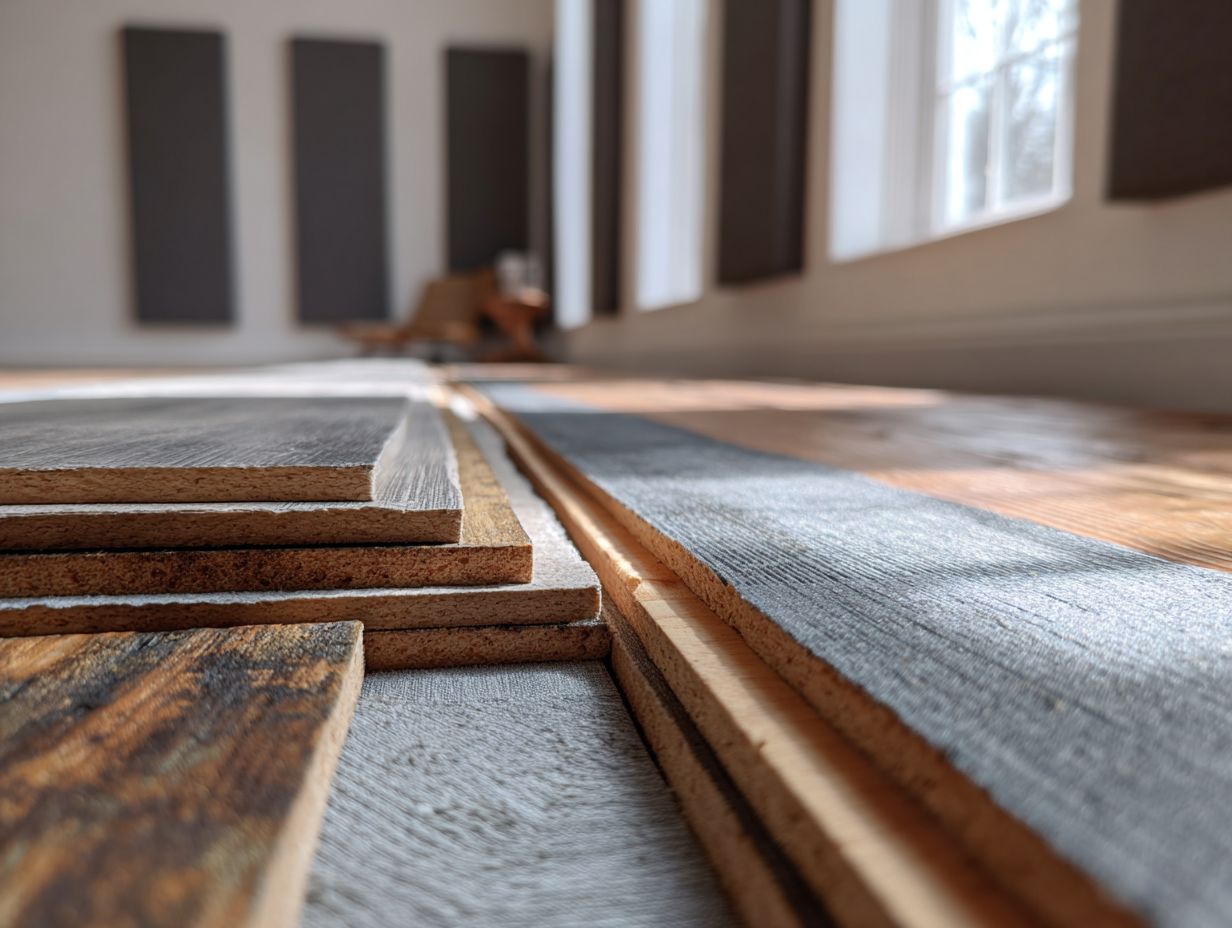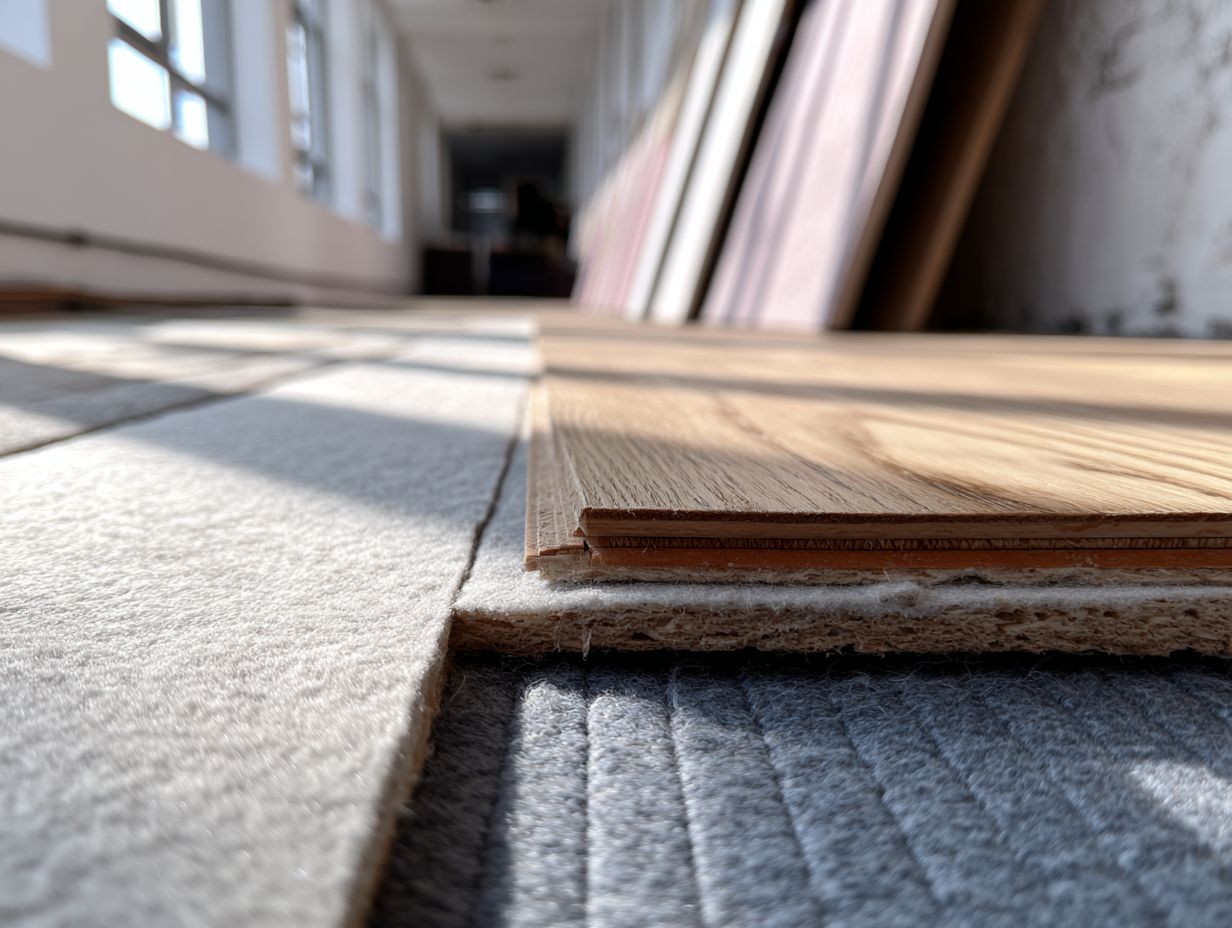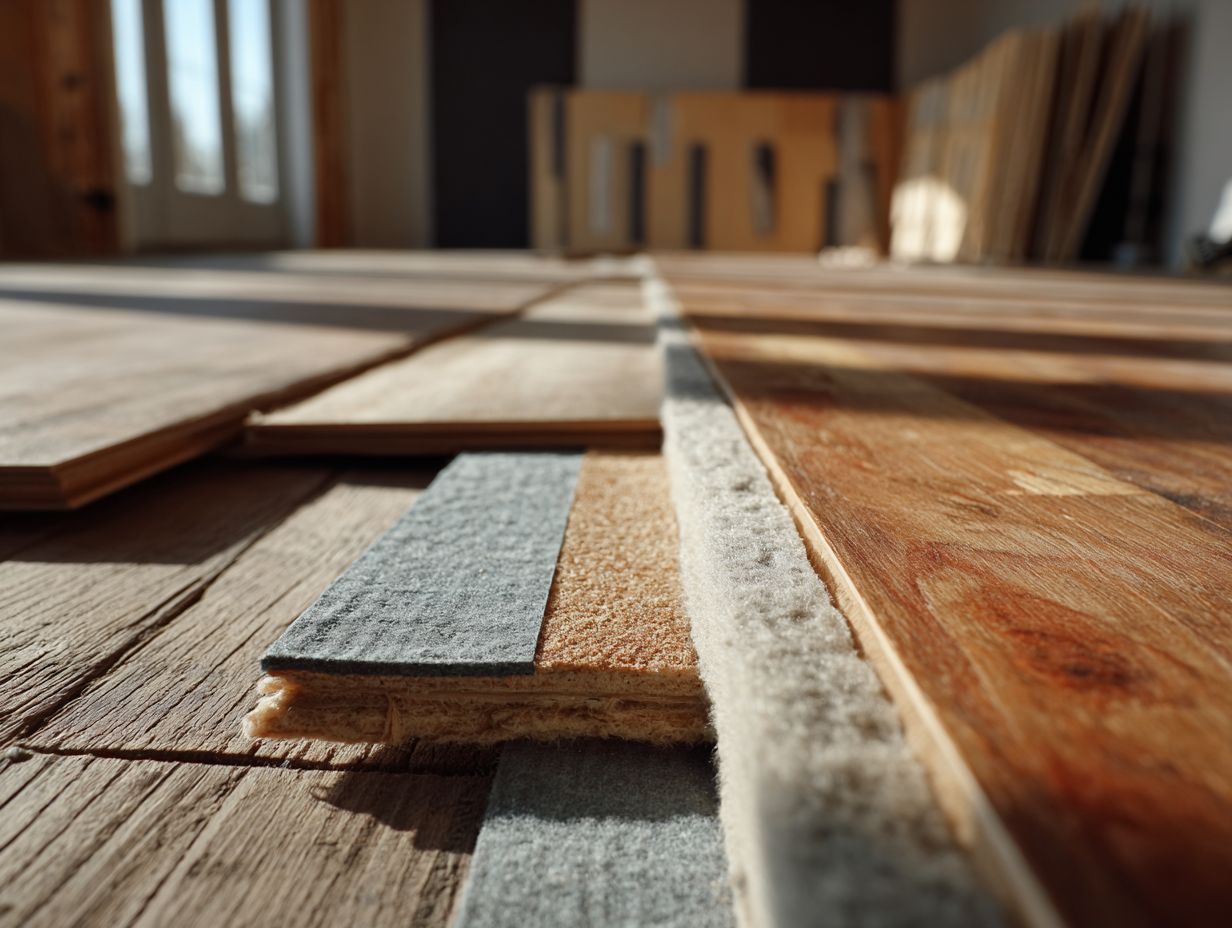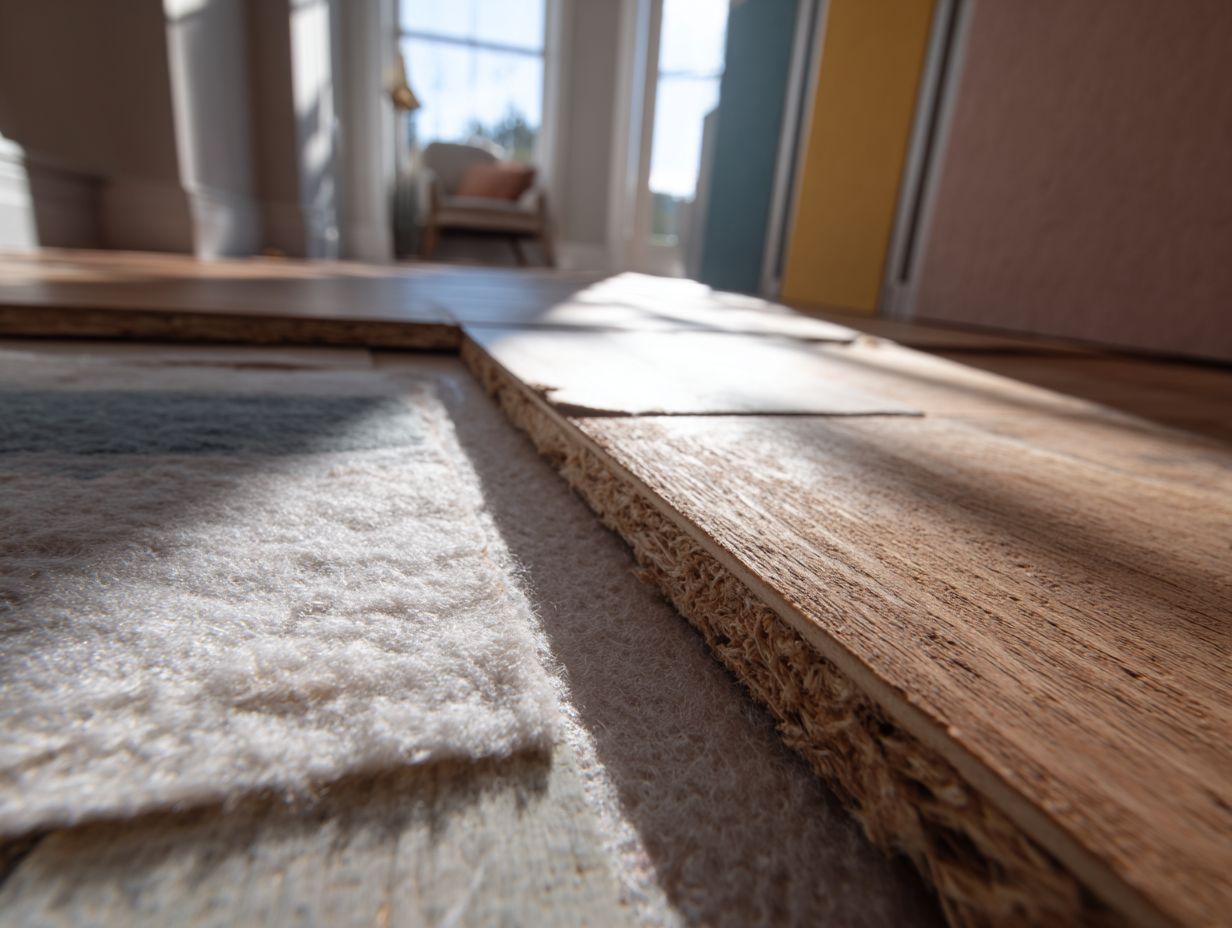Second Floor Flooring – Sound Transmission Solutions
When choosing second floor flooring, sound absorption is key to a peaceful living environment. Choosing the right flooring can greatly improve noise reduction with features like Impact Insulation Class (IIC) ratings and the Noise Reduction Coefficient (NRC). This article looks at Sound-Absorbing Flooring options and their benefits, helping you choose flooring that reduces noise and increases comfort in your home. Learn how to find peace while keeping a fashionable look!
Key Takeaways:
Contents
- Types of Flooring Materials
- Sound Transmission Class (STC) Ratings
- Impact Insulation Class (IIC) Ratings
- Soundproofing Solutions for Second Floor Flooring
- Flooring Soundproofing Statistics
- Absorption Coefficients: Carpet
- Absorption Coefficients: Concrete (unpainted, rough finish)
- Impact Insulation Class (IIC): Engineered Hardwood with Underlayment
- Impact Insulation Class (IIC): Solid Parquet with Foam Backing
- Acoustic Underlayment Options
- Soundproofing Mats and Barriers
- Floating Floors
- Installation Techniques for Sound Reduction
- Regulations and Standards
- Case Studies and Examples
- Frequently Asked Questions
- What is the best type of flooring for reducing sound transmission on a second floor?
- Can I use hardwood or laminate flooring on a second floor without causing sound issues?
- What are some other sound transmission solutions for second floor flooring?
- Is there a way to test the sound transmission of different flooring materials?
- What if I want to install tile or stone flooring on a second floor?
- Can sound transmission solutions for second floor flooring also improve insulation and energy efficiency?
Understanding Sound Transmission

Sound transmission is about how sound moves through various materials, which greatly influences noise levels in houses and other structures.
Sound travels through gases, liquids, and solids as vibrations known as sound waves. For instance, in homes, sound can easily pass through walls, leading to disturbances.
Materials are important for absorbing sound. Rockwool, for example, is highly effective due to its dense, fibrous structure, absorbing a significant amount of sound energy.
Acoustic panels, particularly those made from foam or specialized fabrics, are also popular because they can reduce echoes and improve overall sound quality. Using these materials together can greatly improve soundproofing in any area.
Importance of Sound Control in Buildings
Managing sound well in buildings is important to improve comfort, privacy, and quality of life by cutting down on background noise.
Research shows that excessive noise can lead to various health issues, including stress, sleep disturbances, and cognitive decline-conditions affecting nearly 48% of the urban population.
Implementing sound control techniques such as soundproofing walls using high-density materials, installing acoustic panels, and incorporating double-glazed windows can significantly improve indoor acoustics.
Improvements make people living in the space happier and can raise the property value by up to 20%. Putting effort into reducing noise makes places quieter and more attractive, improving their usability for all people.
Types of Flooring Materials
Different flooring materials are important for how sound travels. They affect how well sound is absorbed and how much noise they reduce, and understanding the role of underlayment can further enhance these acoustic properties. If you’re considering laminate flooring, one of our hidden gems on underlayment types offers in-depth insights that could improve your choice.
Hardwood Flooring
Hardwood flooring is known for its aesthetic appeal and durability but may require additional measures for effective soundproofing.
To improve how well hardwood floors handle sound, check their sound transmission class (STC) and impact insulation class (IIC) ratings. A higher STC rating indicates better soundproofing against airborne noise, while IIC focuses on impact noise.
For instance, a floor with an STC rating of 50 and an IIC of 55 provides a good level of sound insulation.
To improve these ratings, choose underlayment options like cork or rubber.
- Cork offers natural sound absorption and is eco-friendly.
- Rubber is great for lessening sound from impacts, which makes it perfect for homes with more than one floor.
Carpet Flooring
Carpet flooring is great at absorbing sound, which makes it a common choice for homes and businesses.
The sound absorption coefficient of carpet typically ranges from 0.2 to 0.5, significantly outperforming hard surface flooring, which averages around 0.1.
For instance, a plush carpet can reduce noise by up to 30%, compared to the minimal impact of hardwood or tile.
To maximize soundproofing, consider thick carpets with dense padding, such as nylon or fleece types. These options make the sound better and increase comfort, making them ideal for home theaters or offices.
Vinyl and Laminate Flooring
Vinyl and laminate flooring offer stylish and cost-effective options, but their sound dampening properties vary significantly based on selection and installation.
To improve sound quality, use a high-quality underlayment. Mass Loaded Vinyl (MLV) is particularly effective; it can be installed beneath your flooring to significantly reduce noise transfer.
For example, a product like noise-reducing Foam Underlayment can also help, costing around $0.50 per square foot while providing decent sound absorption. Both options improve soundproofing and increase comfort in living areas.
Make sure the base layer fits your flooring needs for the best outcome.
Tile Flooring
Tile flooring, while durable and stylish, typically has poorer sound insulating properties compared to softer flooring materials.
To improve sound insulation with tile flooring, consider using cork underlayment, which can significantly reduce sound transmission while adding comfort underfoot.
When installing, make sure the tiles are lined up properly and use a good adhesive to avoid gaps. You might want to look at tiles with a higher Sound Transmission Class (STC) rating. Some manufacturers make products specifically to improve sound quality.
Add rugs and soft furnishings for additional sound absorption, creating a more serene ambiance in your space.
Sound Transmission Class (STC) Ratings
Sound Transmission Class (STC) ratings offer a standard way to measure how effectively a building material reduces sound.
What is STC?
STC ratings are determined using sound reduction tests across different frequencies. This helps measure how well a material can block sound.
These measurements typically cover frequencies ranging from 125 Hz to 4000 Hz.
In residential flooring, an STC rating of 50-60 is considered effective, significantly reducing airborne noise. For commercial environments, a higher threshold of 60-70 is often recommended, ensuring privacy and reducing distraction.
To improve a space’s STC rating, choose materials like acoustic underlayment or heavy carpets and consider installation techniques that minimize sound transmission, such as floating floors.
Regular assessments of STC ratings help maintain optimal acoustic performance.
How STC Ratings Affect Flooring Choices

Selecting flooring with the right STC rating is important for providing good sound insulation in both new buildings and renovations.
To aid in your selection, consider the following STC ratings for popular flooring options:
| Flooring Option | STC Rating | Best Suited For |
|---|---|---|
| Carpet | 52 | Residential living areas |
| Laminate | 30 | Light commercial spaces |
| Engineered Hardwood | 35 | Apartments and condos |
| Luxury Vinyl Plank | 40 | Retail and offices |
Use underlayment to improve sound absorption, and always check the manufacturer’s guidelines to match your choice with the environment’s sound requirements.
Impact Insulation Class (IIC) Ratings
Impact Insulation Class (IIC) ratings show how well a flooring material can lessen noise from impacts, which is important in buildings with multiple floors.
Understanding IIC Ratings
IIC ratings are determined through standardized tests measuring how well a flooring material diminishes impact sounds like footsteps.
Impact Insulation Class (IIC) tests use a tapping machine to mimic the sound of footsteps. The common frequencies tested range from 100 to 3150 Hz.
Materials with high IIC ratings, such as dense rubber underlays or cork, typically achieve ratings above 50, indicating excellent sound insulation. For example, a rubber underlayment from SilentStep can provide an IIC rating of 67, while cork options like AMORIM offer similar results.
Both options work well for apartment buildings where reducing noise is important.
Comparison of IIC and STC
IIC and STC ratings both measure how well materials block sound, but they focus on different types of noise. IIC deals with noise from impacts, while STC deals with noise that travels through the air. Both are important when selecting flooring.
To achieve a good balance between IIC and STC ratings for effective soundproofing, think about using materials such as cork or carpet. These materials usually have high IIC ratings, which means they are great for reducing noise from impacts.
On the other hand, drywall and mass-loaded vinyl usually improve STC ratings, offering better protection against sounds traveling through the air.
For example, using cork underlayment with carpet can reach an IIC rating of 60 or higher, while adding a layer of mass-loaded vinyl to the ceiling can increase the STC rating to around 50. Aim for a combination that addresses both concerns effectively.
Soundproofing Solutions for Second Floor Flooring
It’s important to use good soundproofing methods for the second-floor flooring to reduce noise reaching the floors below.
Flooring Soundproofing Statistics
Flooring Soundproofing Statistics
Absorption Coefficients: Carpet
Absorption Coefficients: Concrete (unpainted, rough finish)
Impact Insulation Class (IIC): Engineered Hardwood with Underlayment
Impact Insulation Class (IIC): Solid Parquet with Foam Backing

The Flooring Soundproofing Statistics give information on how well different flooring materials perform in terms of sound absorption and their ability to reduce impact noise, as measured by sound absorption coefficients and impact insulation class (IIC) ratings. This information is important for architects, builders, and homeowners when choosing flooring materials that improve soundproofing in homes or businesses.
Absorption Coefficients measure a material’s ability to absorb sound across various frequencies, expressed as a value between 0 (no absorption) and 1 (total absorption). For carpet, the absorption coefficients increase with frequency, from 0.01 at 125 Hz to 0.45 at 4 kHz. This indicates that carpets are more effective at absorbing higher frequencies, which can help reduce echoes and improve speech clarity in a room.
- In contrast, concrete (unpainted, rough finish) shows lower absorption coefficients, starting at 0.01 at 125 Hz and reaching only 0.1 at 4 kHz. This limited absorption means that concrete doesn’t block sound well, especially at higher frequencies, and can cause more echoes.
The Impact Insulation Class (IIC) ratings indicate how well a flooring system reduces impact noise, such as footsteps. Higher IIC values imply better performance in sound insulation:
- Engineered hardwood with underlayment achieves an IIC of 53 on a concrete slab and 52 on a lightweight concrete-capped wood floor. These ratings indicate that installing underlayment for hardwood floors significantly lowers impact noise, making it a good option for buildings with multiple floors.
- Solid parquet with foam backing has an IIC of 55, indicating superior impact noise reduction compared to engineered hardwood. Its Sound Transmission Class (STC) of 51 reflects its ability to block airborne sounds like voices or music, contributing to overall soundproofing.
To sum up, knowing how flooring materials affect sound can help you choose the best option for noise management. Carpets offer better absorption of higher frequencies, while engineered hardwood and solid parquet with underlayment or foam backing provide good impact noise reduction. This information helps to design quieter and more comfortable spaces.
Acoustic Underlayment Options
Acoustic underlayment helps reduce noise between the floor and the subfloor, improving indoor sound quality.
When choosing the right acoustic underlayment, consider options like cork, foam, and mass loaded vinyl.
-
Cork is eco-friendly and ideal for reducing impact noise; it’s great for upper floors.
-
Foam underlayment is both budget-friendly and lightweight, which makes it easy to install. This is why many people choose it for DIY projects.
-
Mass loaded vinyl provides superior soundproofing for lower levels but can be heavier and requires specific installation techniques.
Before installing, make sure the floor underneath is clean and dry. Follow the manufacturer’s instructions closely for the best outcome.
Soundproofing Mats and Barriers
Soundproofing mats and barriers can significantly reduce noise from foot traffic and other impact sounds in multi-level buildings.
For better soundproofing, consider using high-density materials like Mass Loaded Vinyl (MLV) because it works well in blocking low frequencies.
Another effective choice is rubber soundproofing mats, which absorb vibrations and are ideal for installation beneath flooring.
Installation methods vary; rubber mats typically roll out easily over subfloors and can be secured with adhesive, while MLV often requires hanging with specific fasteners or adhesives.
Both choices lower noise a lot, which is why they are widely used in houses and workplaces.
Floating Floors
Floating floors reduce noise by separating the flooring from the subfloor, providing an effective soundproofing method.
To improve noise reduction, an underlayment is essential. This material absorbs impact sounds and creates a barrier, improving acoustic performance.
For example, choices like cork, rubber, or felt underlayment are effective in dampening foot traffic noise.
To install, first make sure the subfloor is clean and dry. Next, put down the underlayment, and then place the floating boards.
Look at choices like laminate or engineered hardwood. People like them because they look nice and are easy to put in, often completing a typical room in just a weekend.
Installation Techniques for Sound Reduction
Proper installation methods are important for getting the best soundproofing results from flooring materials in any building.
To achieve optimal sound reduction, focus on techniques such as using staggered seams, which prevent sound waves from transferring between planks.
Using acoustic caulk in joints and seams improves sound isolation by filling gaps that might let noise pass through.
Consider installing sound-absorbing underlayment, which can significantly dampen sound transmission. These methods improve sound quality and can be supported by YouTube tutorials that offer detailed instructions for successful application.
Regulations and Standards
Knowing building rules and industry standards is key for meeting requirements and achieving the best sound quality in construction work.
Building Codes on Sound Transmission
Building codes dictate the minimum requirements for sound transmission control, ensuring safety and comfort in dwellings.
For instance, California’s Title 24 mandates sound transmission class (STC) ratings for walls and floors, requiring at least an STC of 50 in multi-family units.
In contrast, New York City’s Building Code emphasizes a minimum impact insulation class (IIC) of 50 for floor assemblies.
These regulations influence flooring choices significantly, often leading builders to opt for materials like acoustic underlayment or resilient flooring systems.
Using methods like staggered seams and floating floors helps control noise, meets local rules, and improves sound quality.
Industry Standards for Acoustic Performance
Industry standards for acoustic performance establish benchmarks for evaluating noise control solutions in various environments.
Two prominent standards you should be aware of are ASTM E90 and ASTM E492. ASTM E90 focuses on measuring airborne sound transmission loss, allowing you to assess how well a material can block sound between spaces.
On the other hand, ASTM E492 evaluates how sound from impacts travels through structures. This is important in buildings with multiple floors where noise from footsteps can be bothersome. Find out how to select materials and options that meet your soundproofing requirements, ensuring they comply with local building regulations and increase comfort for people indoors.
Case Studies and Examples
Looking at actual examples helps us understand how soundproofing works in real situations, showing what methods work well and the results that follow.
Successful Soundproofing Projects

Showing examples of successful soundproofing projects demonstrates how different methods and materials can be used to reach the intended results.
In one project, a client converted a noisy home office into a quiet workspace using acoustic panels and soundproof curtains, resulting in a 65% sound reduction. This setup cost approximately $800.
Another project involved a recording studio where specialized drywall and insulation materials were employed, achieving a 90% reduction in external noise for $3,500.
Both clients reported significant improvements in focus and audio quality, with one stating, “The difference was night and day-the sound quality is now absolutely perfect for my recordings.”
Lessons Learned from Past Implementations
Reviewing previous projects helps learn key lessons that can make upcoming soundproofing and planning more effective.
For instance, common pitfalls include inadequate sealing of gaps, which can significantly diminish soundproofing effectiveness. Always use acoustic caulk to seal edges around doors, windows, and vents.
Choosing the wrong materials can lead to subpar results; for example, mass-loaded vinyl is notably effective when applied to walls or ceilings.
Involving professionals during installation can help you avoid mistakes. Using high-quality soundproofing materials together with professional advice can greatly improve a project.
Frequently Asked Questions
What is the best type of flooring for reducing sound transmission on a second floor?
The best type of flooring for reducing sound transmission on a second floor is carpet or cork flooring. These materials have inherent sound-absorbing properties that can help reduce noise between floors.
Can I use hardwood or laminate flooring on a second floor without causing sound issues?
While hardwood and laminate flooring may be a popular choice, they can contribute to sound transmission on a second floor. To reduce noise, it is recommended to use underlayment materials, such as rubber or cork, underneath these types of flooring.
What are some other sound transmission solutions for second floor flooring?
In addition to choosing the right type of flooring, there are other solutions for reducing sound transmission on a second floor. These include using acoustic mats or soundproofing insulation between floor joists and adding area rugs or carpet runners to absorb noise.
Is there a way to test the sound transmission of different flooring materials?
Yes, there are various methods for testing the sound transmission of different flooring materials. One common method is the Impact Insulation Class (IIC) rating, which measures how well a floor can reduce impact noise, such as footsteps, from the floor above.
What if I want to install tile or stone flooring on a second floor?
Tile and stone flooring can also contribute to sound transmission on a second floor. To minimize noise, it is recommended to use a soundproofing membrane or underlayment specifically designed for these types of flooring.
Can sound transmission solutions for second floor flooring also improve insulation and energy efficiency?
Yes, many sound transmission solutions, such as underlayment materials and soundproofing insulation, can also improve insulation and energy efficiency in a home. This is because they add an extra layer of protection and can help reduce drafts and air leaks.



